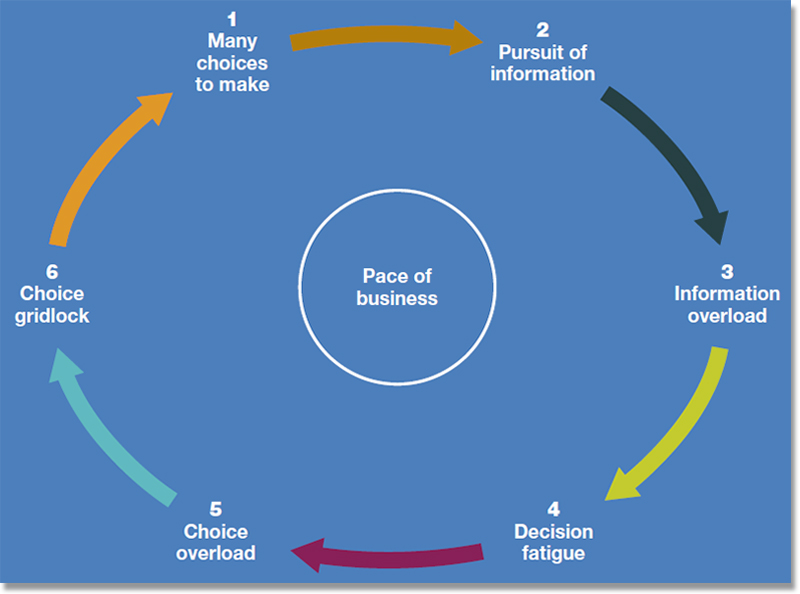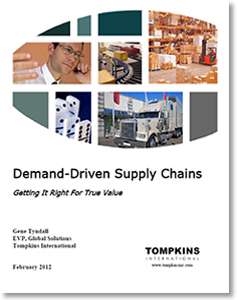Choices That Drive Supply Chain Excellence

Supply chain managers are overwhelmed with choices and information, and too often the result isn’t decisiveness, but gridlock, the answer; put in place strong leadership that gets to the choices that drive supply chain excellence.
“Water, water every where, Nor any drop to drink.” From The Rime Of The Ancient Mariner.
The old sailor telling his tale in Samuel Taylor Coleridge’s poem has just returned from a long voyage.
He recounts how he shot an albatross that was once viewed as a good omen for the voyage, and how he was then blamed by his crew when the winds turned against them and they were trapped on a ship going nowhere, depleting their supplies.
They were surrounded by salt water, but neither he nor the rest of the crew had a drop of fresh water to drink. It became the albatross around his neck.
In today’s business world, those lines could be updated for any manager who, like the ancient mariner, is surrounded by data and information and choices to be made based on that information - in fact, there can be so many choices and so much information that it is difficult to move the ship forward.
Think of it as “choice overload.” As with the ancient mariner, the plethora of choices becomes an albatross around the manager’s neck.
While choice overload could apply to any functional area of an organization, I believe there is no area within product-based companies where this is more applicable than the supply chain.
Managers are challenged every day to make the right decisions to get orders out the door, deal with the inevitable hiccups of late deliveries, inventory shortages and quality miscues all while coming up with new processes to enable new business strategies.
Therefore, although this article has application across a business, the necessity for avoiding choice overload is greatest when it comes to making supply chain choices.
For that reason, I think it is important that supply chain managers put in place a foundation of strong leadership that can cut through the choice overload and make the decisions that drive supply chain excellence.
The following is a look at what I call the “cycle of choice overload” as well as recommendations for supply chain leaders who want to break the vicious cycle, and get the albatross off from around their necks.
The Cycle of Choice Overload
The first time I wrote the introduction to this article it sounded like I was writing advertising for a new energy drink. The feeling was a never-ending string of questions like:
- Are you having a hard time keeping up with the pace of business?
- Has the rat race made you feel like a mouse?
- Is your job on a treadmill - you keep running faster but don’t get anywhere?
- Has the vicious cycle of your daily routine worn you down to the point of inaction?
- When you see a hamster running in one of those wheels, do you empathize with the hamster?
It felt like I should answer those questions with a response like: “Buy the new miracle, vitamin-packed energy drink that will restore your energy and allow you to take control and win the gold medal in the rat race that is today’s challenging business environment.”
The only problem with this is that there is no new energy drink to achieve these results. In fact, the reality is that you can’t overcome feelings of being overwhelmed through an energy drink, but only by understanding the downward cycle of choice overload.
Let’s start by taking a look at Figure 1, which illustrates the endless cycle of choice overload.
Figure 1. Choice Overload

Source: Tompkins International
The chart can be viewed from the perspective of an individual or an organization, but I’d like to consider the individual perspective.
Figure 1 begins with the “many choices to make,” that is the hundreds of decisions that you, as a manager, must face and cope with in order to adapt to the accelerating pace of business and the resulting changes in the competitive landscape.
In step 1, you are faced with more choices than ever before. These could range from the simple buy versus make decision that might range from managing a process in house versus outsourcing it to a third-party logistics provider to automating a conventional warehouse or creating new and innovative processes to deal with same-day shipping in the fast-changing world of e-commerce fulfillment.
Many of these decisions are make-or-break for your supply chain - and your career.
Who hasn’t heard the story of the distribution or transportation manager who boldly went out on a limb to implement a new technology and became a hero when it went well, or a zero when it failed?
After all, there’s a reason for the old saying: “No one ever got fired for buying IBM.”
The fear, uncertainty and guilt that accompany a make-or-break career decision leads to step 2, “the pursuit of information.” In an effort to assure yourself that you’re making the right choice, you seek out more and more information.
And, with more data being collected and analyzed from more nodes in the supply chain, managers have access to more data than ever before, leading them inexorably to step 3, “information overload.” Yes, there is information, information everywhere, but without the right tools and analysis, no one can make sense of it all.
That gets us to step 4, “decision fatigue.” This is where managers are exhausted from the consideration of the many options in front of them, which all seem equally good - or bad. It’s like staring at the dozens of items on a take-out menu, all with appetizing descriptions.
As a result, managers find themselves at step 5, “choice overload.” Ultimately, just as we often ask the waiter to come back to the table time and time again before ordering, choice overload prevents managers from making choices in a timely fashion. Thus the choices that have yet to be made pile up on top of one another.
In step 6, “choice gridlock,” decisions are postponed, nothing gets done and you may begin to empathize with the hamster. Ultimately, the cycle repeats itself and you are back at step 1, with a new set of choices to consider and even more information to work through.
While I just looked at this from the perspective of the individual manager, this never-ending spiral can happen just as well to an organization. The amount of frustration that results from the choice overload cycle is huge; without strong leadership in place, this cycle has been responsible for many organizations that fall behind their competitors because they were unable to keep pace with the demands of the market.
The challenge for an organization, or a supply chain manager, is to define the kind of leadership response that is required to bust out of this vicious cycle; get back on top of choice overload; and raise the supply chain organization to a level of adaptation that results in success.
Here are my step-by-step strong leadership responses to the cycle of choice overload
Step 1: Many Choices to Make
Strong leadership will address “many choices to make” through prioritization. Now, some view prioritization as deciding which task is most important. Second, third and so on.
While that is a form of prioritization, it is not what I mean by using prioritization as a strong leadership response. Instead, a strong leader prioritizes by eliminating the choices that are trivial and have no real impact on the path forward.
Next, the strong leader makes “no-brainer” choices quickly and decisively. From there, the strong leader delegates low-impact choices to someone who can make a decision without consuming the time of people who are needed for more critical choices. By then, the strong leader can launch the more thoughtful task of deciding who should make the remaining important choices that will drive excellence.
Interestingly, by the time the trivial, no brainier, and low-impact choices are satisfied, the list of decisions that remain to be made is much shorter and manageable.
Once it is pared down, choosing which individual or group of individuals should make which, the hard choices are much easier, as often more than half the original set of tasks has been eliminated.
When making decisions about who should make choices, care must be taken to ensure that different perspectives and views are represented. Obviously, assigning four people who share the same view does not help come to the right decision, as you can end up with a group think response.
Once the correct people are assigned to make the important choices, the strong leader’s role is reduced to managing timelines, participating in the establishment of criteria for the choices and ensuring that once closure is reached, the implementation of the choices takes place. If an individual is selected to participate in several choices, a strong leader will either alter assignments or prioritize the level of importance of the choices.
Step 2: Pursuit of Information
As anyone who has spent hours of time Googling a topic on the Internet knows, there is an unbelievable amount of data available on almost any subject.
It’s easy to go down a rabbit hole following one link to another. Many people want to know it all: They have a desire to seek information that is interesting, but not really needed to make the assigned choices.
Strong leadership, however, knows the difference between data and information. Indeed, a strong leader will make certain that only the information truly needed for the task at hand will be pursued.
Lastly, a strong leader is certain to characterize the level of precision needed in the information being sought. The level of effort required to obtain the information that is really needed can easily approach a factor 10 times over the data sought by some managers in making choices.
Step 3: Information Overload
The most frequent reason for “information overload” is weak leadership during step 1 (by not prioritizing choices) and step 2 (by pursuing too much data or irrelevant information).
Strong leadership eliminates clutter and useless information and cuts to the core of the trends and data required to make choices.
An additional factor here is the failure that often occurs when weak leaders try to force people to make decisions sooner than the right information is available upon which to make choices.
This pressure is rarely productive and also rarely leads to sound decisions. Moreover, it often wastes a tremendous amount time and undercuts the ability for individuals or teams to make good choices.
Step 4: Decision Fatigue
Strong leadership minimizes “decision fatigue” by developing well defined and agreed upon decision criteria, choice deadlines, and the right focus while making choices.
Strong leadership also makes sure that people are well informed about other choices that are being made within the organization.
That is because the consequences of one choice often have an impact on another choice being made elsewhere.
Strong leaders also realize that when more collaboration is required to make a choice, more energy is also required. Therefore, to reduce decision fatigue, strong leaders must also only involve the people who should be involved.
Finally, strong leadership minimizes second-guessing and encourages people to close out choices and move on; that includes choices in which they were involved and decisions made by others in the organization.
Continual second-guessing or re-litigating choices that have already been made will significantly contribute to decision fatigue. It will also reduce the effectiveness of an organization’s progress. If bad choices have been made, they should not be revisited or re-argued, but instead should be viewed as a new choice and begun anew.
Step 5: Choice Overload
Strong leadership will make sure that decision fatigue and choice overload do not lead to stagnation. Sometimes called “analysis paralysis,” stagnation can spread choice overload like a virus.
Combined with the pressure to make choices, stagnation can result in step 6, “choice gridlock.” Strong leadership is needed to manage “choice overload” and to reduce the pressure and stress that so often leads to gridlock.
Strong leadership will orchestrate a time out to reduce fatigue by making some no-brainer choices and utilize that momentum to get the organization moving forward again.
Step 6: Choice Gridlock
Strong leadership must realize the criticality of choice gridlock and the urgency to eliminate it. Just working harder while maintaining the status quo is not enough; the organization needs a reset and everyone bogged down by the gridlock must be aware that it has happened.
The organization of the choices and the responsibility of the choices must be dramatically changed. Fear of making bad choices must be eliminated and people must be made aware of the importance of getting closure.
Strong leadership makes it clear that not making a choice is a choice. In fact, procrastination is also a choice, one that leads to gridlock and that must be broken through.
Procrastination, and the architecture or structure of choices, must be altered; meanwhile, new realistic deadlines must be established. Patience when facing choice gridlock is not strong leadership; rather, it encourages more procrastination.
Choices, Choices Everywhere
Organizations and individuals have a large number of choices to be made every day. Most are straightforward and can be made quickly.
Many, however, are important and need to be made after considering many factors. The old adage “you make your choices and then your choices make you” is true. Due to the increasing pace of life and business, making timely choices is more important than ever.
Unfortunately, many of us are experiencing choice overload. The impacts of this are enormous - too often, overload begets gridlock and, like the ancient mariner, gridlock becomes an albatross around a manager’s neck.
It is only with strong leadership that choice overload can be eliminated and an orderly process of making high quality, timely choices may be restored.
Remember: The choice is yours.
About the Author: James A. Tompkins, Ph.D., is the CEO of Tompkins International and has authored or contributed to more than 30 books. He can be reached at [email protected].
Article Topics
Tompkins International News & Resources
The Supply Chain is Dead. Long Live the Ecosystem Apple’s iPhone 7 Facing Supply Chain Shortages as Production Ramps up Ahead of Launch Demand-Driven Supply Chains Speculation that Walmart is in Talks to Buy Online Retailer Jet.com Retail at a Crossroads: Future Hangs in the Balance as Retail Industry Passes Tipping Points Choices That Drive Supply Chain Excellence What Is Supply Chain Network Design & Why Is It Important? More Tompkins InternationalLatest in Supply Chain
Apple Accused of Multiple Human Rights Violations UPS Struggles in First Quarter With Steep Earnings Decline How Supply Chains Are Solving Severe Workplace Shortages SAP Unveils New AI-Driven Supply Chain Innovations How Much Extra Will Consumers Pay for Sustainable Packaging? FedEx Announces Plans to Shut Down Four Facilities U.S. Manufacturing is Growing but Employment Not Keeping Pace More Supply Chain














